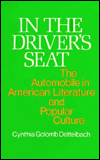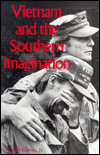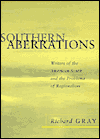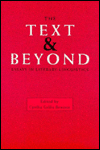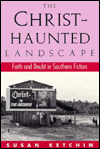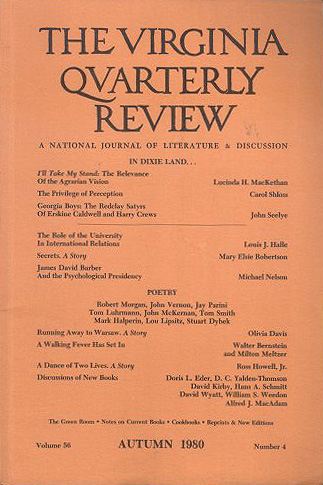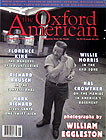The academic world was not much engaged by Crews' early work. His novels were absent of the self-reference or irony in vogue then and deceptively cinematic: all story, character, and device. Reviewing Craft and Vision in 1973, Sterling Watson paid a very writerly tribute to Crews's story "An Uncertain Smile" by upholding its marriage of "craft, the tool, and vision." It was not until A Feast of Snakes and A Childhood that academics—including David K. Jeffrey and Gary L. Long, who count among his strongest supporters—recognized the incipient themes of cultural and spiritual malaise in Crews's post-agrarian South. With some foresight, Jeffery edited A Grit's Triumph: Essays on the Works of Harry Crews [Port Washington, NY: Associated Faculty P, 1983] which developed these arguments within a critical context. A Grit's Triumph remained the major single source of critical inquiry until 1998 when The Southern Quarterly published the Harry Crews issue.
In March 2001, University Press of Mississippi published Perspectives on Harry Crews (Amazon | eBay), a collection of the essays from The Southern Quarterly issue on Crews.
"Agrarian Nightmare: Harry Crews' Dark Vision in Naked in Garden Hills." The Southern Literary Journal 34.1 (Fall 2001): 68-78.
"Fast Food/Quick Lunch: Crews, Burroughs, and Pynchon." Literary Gastronomy. David Bevan, editor. Rodopi Perspectives on Modern Literature. Rodopi, 1988: 19-27.
Ames's essay examines how these three authors have written novels whose characters inexorably join oral and anal desires—with Crews, it's Herman Mack's ingestion and excretion of car bits, "These heterogeneous elements, swallowed one by one, constitute the carapace of car, container of the American monad par excellence," which serve as a "grotesque homage" to the auto-fixation of the novel's characters and culture.
"Send the Bloody Intellectuals to Gym: Harry Crews's Educated Super(wo)men and Victims of Both Sexes." The Many Souths: Class in Southern Culture. Waldemar Zacharasiewicz, editor. Tubingen, Germany: Stauffenburg Verlag, 2002: 167-174.
"Sex-Obsessed Missionaries in Harry Crews's The Gospel Singer and their Literary Predecessors." Spirituality and Religion in American Culture. Matthew Sweney & Michal Peprnik, editors. Olomouc (Czech Republic): Palacky University (Univerzita Palackeho) Press, 2002: 91-99.
"Tradition and the Individual Talent in Folklore and Literature." Western Folklore 59 (Spring 2000): 105-114.
"Body Language in Harry Crews's The Gypsy's Curse." Critique: Studies in Contemporary Fiction 23.2 (Winter 1981-82): 61-66.
Beatty examines the significance of verbal and non-verbal communication among men in The Gypsy's Curse.
"Crews's Women." A Grit's Triumph: Essays on the Works of Harry Crews. David K. Jeffrey, editor. Associated Faculty Press, 1983: 112-123.
Comic Visions, Female Voices: Contemporary Women Novelists and Southern Humor. Louisiana State University Press, 1998: 13, 85.
The text briefly points on two occassions to Crews in the context of writing by men:
"For example, women do not usually attack the physically handicapped, choosing instead to attack those who hold narrowminded attitudes and adhere to cultural stereotypes. An example illsutrating how male writers do not follow this 'rule' is found in Harry Crews's 1995 novel, The Mulching of America; much of Crews's humor is at the expense of unfortunate characters [ . . . ] The character is an authority figure, but instead of attacking his innefectual leadership, Crews mocks his physical deformity per se, a rare occurrence in female writing." [13].
"A Response to 'Rereading Harry Crews' A Feast of Snakes' by Michael Spikes." The Arkansas Review 4.2 (Fall 1995): 274-276.
Birden responds briefly to Spikes' argument [See Spikes (1995 Spring)] that Mackey willfully chooses a morally repulsive repsonse to his existential circumstances. Birden counters that characters exist at the bidding of their authors, are constrained by the elements of narrative construction, and are not, above all, alive or capable of expressing free-will:
"Any choices that are made for the fate of this character are made by Crews, and it is certainly the artist's prerogative to decide what will happen to his characters."
Perspectives on Harry Crews. University Press of Mississippi, March 2001
Collects the critical essays previously published in the special Harry Crews issue of Southern Quarterly (Fall 1998).
"Wright and Crews: Southern Childhoods." Southern Exposure 8.3 (Fall 1980): 120-23.
"Harry Crews and the Southern Protestant Church." A Grit's Triumph: Essays on the Works of Harry Crews. David K. Jeffrey, editor. Associated Faculty Press, 1983: 79-99.
"Crews' Blues: Manic-Depression in A Feast of Snakes." Journal of Evolutionary Psychology 17.1-2 (March 1996): 37-43.
"1970 Images of the Machine and the Garden: Kosinski, Crews, and Pirsig." Soundings: A Journal of Interdisciplinary Studies 61.1 (1978): 105-122.
One of the few instances Crews shares space with other contemporary authors. Perhaps the lack of popularity, of which Crews often expresses consternation, comes from the lack of apparent connections with what postmodern critics deem important: ambiguity and fracture. It's enticing to think what kind of popularity Crews would enjoy if some element of his writing appealed to postmodernism. It is also interesting to think that Crews's straight narrative style may enjoy retroactive popularity once audiences, frustrated by the very same elements of ambiguity and fracture, tire of postmodernism as a writing genre.
"Discovering a Literary Form." A Sourcebook of American Literary Journalism: Representing Writers in an Emerging Genre. Thomas B. Connery, editor. Greenwood Press, 1997: 32.
"The Violent Bear It as Best They Can: Cultural Conflict in the Novels of Harry Crews." Studies in the Literary Imagination 27.2 (Fall 1994): 75-86.
Covel identifies elements of the violence in Crews's work that are also inherent in the conflict between the old and new South and places his work within the context of traditional Southern regionalists—Faulkner and O'Connor—except that Crews's characters search for holds in the crumbling landscape of the modern South and resort, lacking appropriate emotional outlets, to "violent rituals" in response to the threat of encroaching urbanization. Includes works cited.
"Because of conflicting social realities, Crews's characters, especially in his early novels, feel disenfranchised and powerless to control their own lives. The violent rituals in which they engage (sports, psuedo-religious ceremonies, sexual activity) provide a momentary sense of empowerment for some of the characters. In the earlier novels, the rituals fail, resulting in nothing more valuable than random violence. In contrast to the earlier novels, Crews's latest novel, Scar Lover, hints that meaning, purpose, and love might in fact result from violent rituals, thereby issuing in a different sort of shift from rural lifestyles and values to urban lifestyles and values."
"Harry Crews." American Literary Journalists, 1945-1995. Arthur J. Kaul, editor. Dictionary of Literary Biography. Gale Research Company, 1997: 56-62.
"Harry Crews on the American Dream." Southern Quarterly 20.3 (Spring 1982): 35-53.
The authors contend that the illusion of upward mobility is an over-arching theme in the novels to A Feast of Snakes which bridges the otherwise disparate and novel-specific concerns of success and failure. The authors examine how each novel's particular theme reinforces their argument, that "Crews moves from describing illusions of the successful and the failed to suggesting that mobility itself is an illusion"—as Crews says, "how the dream always becomes a nightmare."
"When read separately, Crews's novels are striking for their bizarre characters. Over the course of his novels, however, freaks begin to seem normal, and normal persons seem strange. Bizarre characters, whether freakish or normal, are overshadowed by a bizarre society. The totality of Crews's work builds a context that explains his characters. The distance between 'normals' and 'freaks' is reduced, and modern people become more alike than different; they share the universal handicap of hope."
"Harry Crews's A Childhood: A Resource for Teaching Sociology." Teaching Sociology 9.4 (July 1982): 452-460.
In the Driver's Seat: The Automobile in American Literature and Popular Culture. Greenwood Press, 1976: 99-101.
"Everthing Is Eating Everthing Else: The Naturalistic Impulse in Harry Crews's A Feast of Snakes." Southern Quarterly 37.1 (Fall 1998): 42-53.
"A Childhood, The Gospel Singer, and Writing: Harry Crews's Rituals of Exorcism." Mythes, Croyances et Religions 18 (2001): 89-97.
Full text available at the author's web site.
From the abstract: "Harry Crews's 1978 autobiography, A Childhood, provides a clue for reading the work of this Southern writer born during the Depression in the poorest county in Southern Georgia. Crews writes that he was five when he 'awakened' to himself and to the world around him, where 'survival depended on raw courage . . . born out of desperation and sustained by a lack of alternatives.' To be able to live with the mystery and terror of his everyday life, Crews, at five, started to invent stories for the figures he found in the Sears, Roebuck catalogue, a habit which led to his first published novel, The Gospel Singer, in 1968."
"Tragedy on the Road to Enigma: Ritual Death in Harry Crews's The Gospel Singer." Southern Quarterly 39.4 (2001): 58-62.
Full text available at the author's web site.
Vietnam and the Southern Imagination. University Press of Mississippi, 1992.:
From the publisher: "James Webb, Bobbie Ann Mason, Jayne Anne Phillips, Clyde Edgerton, Madison Smartt Bell, Barry Hannah, Winston Groom, Gustav Hasford, Harry Crews, Larry Brown, Sydney Blair, Pat Conroy, David Huddle, Yusef Komunyakaa, and Walter McDonald have found in Vietnam many provocative echoes of fundamental issues that first came to a head in the American Civil War." [Unconfirmed]
"The World is Here: Fiction Writing and Social Change in the Contemporary South I." Southern Aberrations: Writers of the American South and the Problems of Regionalism. Louisiana State University Press, 2000: 342-415.
Gray's essay contains multiple references to Crews's work.
"The Grit Emigre in Harry Crews's Fiction." Southern Quarterly 38.1 (Fall 1999): 164-172.
After Southern Modernism: Fiction of the Contemporary South. UP of Mississippi, December 2000
This sweeping study of the literary South's new direction focuses on nine well established writers who, by breaking away from the firmly ensconced myths, have emerged as an iconoclastic generation—Harry Crews, Dorothy Allison, Bobbie Ann Mason, Larry Brown, Kaye Gibbons, Randall Kenan, Richard Ford, Cormac McCarthy, and Barry Hannah. Resisting the modernist methods of the past, they have established their own postmodern ground beyond the shadow of their predecessors.
A Grit's Triumph: Essays on the Works of Harry Crews. Associated Faculty Press, 1983
A collection of ten previously published essays, including two by Jeffrey and two by Shelton, and a previously published interview with Crews [see Jeffrey (1981) Interviews].
"Crews's Freaks." A Grit's Triumph: Essays on the Works of Harry Crews. David K. Jeffrey, editor. Associated Faculty Press, 1983: 67-78.
"Murder and Mayhem in Crews' A Feast of Snakes." Critique: Studies in Modern Fiction 28.1 (Fall 1986): 45-54.
Jeffrey examines images of excrement, snakes, and dog-fighting in A Feast of Snakes as preparation of the reader for the great violence at novel's conclusion, which represents not madness or despair, but an escape from social and existential frustration.
"The Athlete's Hand Filling Up: Harry Crews and Sports." A Grit's Triumph: Essays on the Works of Harry Crews. David K. Jeffrey, editor. Associated Faculty Press, 1983: 100-111.
"'You gone have to learn to talk right': Linguistic Deference and Regional Dialect in Harry Crews's Body." The Text and Beyond: Essays in Literary Linguistics. Cynthia Goldin Bernstein, editor. U Alabama Press, 1994: 278-295.
"Violence and Civility in Discourse: Uses of Mitigation by Rural Southern White Men." The SECOL Review (Southeastern Conference on Linguistics) 16.1 (Spring 1992): 1-19.
Johnstone, analyzing the speech patterns of white males in Body, attends to the notion of linguistic deference, finding that, what she calls hedges and indirectness, serve two functions: "Not only can these forms serve as markers of respectful politeness . . . but they can also serve the opposite function: they can serve to mark belligerence." Johnstone shows what all Southerners know by cliche, that they can be polite to the point of blood.
What is more exemplary, though, is Johnstone's brief but effective examination of how Crews successfully recreates Southern speech. By looking at "the accuracy of the author's representation of speech features that [have] been well studied, in the phonological, morphological, and syntactical levels," Johnstone shows that how Crews represents Southern dialect matches what linguists have documented through research. Johnstone provides a measure of objective proof of what has been said frequently, "that Crews has a fine ear for speech."
"True parity in social rank seems not to exist among these men; interaction among potential equals involves constant negotiation for status. Their constant awareness of social rank, and the linguistic forms by which they express this awareness, are an important part of what makes Crews' characters seem Southern."
"The Writer as Shaman." The Christ-Haunted Landscape: Faith and Doubt in Southern Fiction. U Mississippi Press, 1994: 326-329.
Section devoted to Crews contains a brief essay, "The Writer as Shaman," which introduces the reader to Crews's themes and includes an extended excerpt from Scar Lover illustrating her argument.
Also, an interview, conducted in Raleigh, North Carolina, during a previewing of Gary Hawkins' documentary The Rough South of Harry Crews.
[See Ketchin (1994) Interviews].
"Patterns of Adaptation: Place and Placelessness in Contemporary Southern Fiction." Studies in the Literary Imagination 27.2 (Fall 1994): 1-7.
Kramer, in his introduction to issue's critical essays, identifies the tendency of Southern fiction to reflect the transformation of the South and the adaption of individuals to new modes of living without giving way to myth-making or white-washing. In reference to Covell's essay ("The Violent Bear It as Best They Can"), Kramer writes, "Crews might say he did not make the world of present-day Jacksonville, Florida, but there is little doubt that his characters learn to live in such ugly places."
"Carnivalesque Rituals and the Theological Grotesque in the Southern Novels of Cormac McCarthy and Harry Crews." Cormac McCarthy: Uncharted Territories/territoires inconnus.. Christine Chollier, editor. Reims: PU de Reims, 2003: 61-71 (English), 229-239 (French).
"Having a Hard Time of It: Women in the Novels of Harry Crews." Southern Quarterly 37.1 (Fall 1998): 54-65.
"Grit Truths: The Journalistic Essays of Harry Crews." The Texas Review 9.1-2 (Spring-Summer 1988): 96-109.
"Literary Criticism and the Fate of Ideas: The Case of Harry Crews." The Texas Review 4.3-4 (Fall-Winter 1983): 69-91.
The authors contend that subjective review of literature is of specious value, that reviewers bring to their task a collection of ill-suited analytic tools, and worse, that the practice of the subjective review tends to hamper the selection and promotion of a novel's true value. The authors' conclusions are based on their own critical analysis of Crews's novels, "which cohere around the theme of social mobility."
The reviews of Crews's work—at the time, eight novels, the autobiography, and two non-fiction collections—exemplify the reviewer's tendency to draw incongruous conclusions: "Even a casual reading suggested a tangle of apparently inconsistent observations, arbitrary evaluations, and contradictory conclusions." The authors analyze the content of 138 reviews and 15 articles and interviews and find six distinct categories of ineffectual analysis.
The authors conclude that "patterns in the reviews of Crews's writing illustrate more than a misunderstanding of him." The authors fear that misrepresentation of Crews's work has consequences beyond merely setting literary taste, that reviewers who miss the point of Crews's work in fact support the framework Crews's novels attempt to destabilize. And overall, as purveyors of mainstream culture, reviewers "become arbiters of 'correct' portrayals of culture, and as agents for its illusions, they become censors."
Includes a comprehensive bibliography of the reviews acquired for the content analysis.
"When considered together, Crews's eight novels deflate modern beliefs about mobility and describe the enduring effects of class. They detail the course of change in the twentieth century from the point of view of those at the bottom of the social order, who by and large remain there. Modern society creates a crisis of ambition which consists of hope without opportunity and success without substance."
"Naked Americans: Violence in the Work of Harry Crews." Southern Quarterly 32.4 (Summer 1994): 117-130.
Long's essay is a thorough and complex analysis of the relationship between community-sense and violence in Crews's work. Long identifies in the novels instances of violence, making thematic connections between violence and modern society.
Again, as with previous essays, Long emphasizes that violence is not gratuitous, without consequence or significance, as reviewers and critics have otherwise noted: "If Crews uses violence as an expedient, it does not work. Most of his books are out of print." Long's primary point is that these notions "trivialize the importance of violence in his novels."
Long argues that violence is a reaction to the transformation of the agrarian South to a modern industrial region. The old South was a closed region of communities, linked by language, lifestyle, culture, place, and history. Industrialization and rampant consumerism have infested the South with the standard, good-for-all American culture.
Long argues that Crews's characters are missing something vital to their lives as a result of the transformation—"People are cut off from each other and disintegrated, detached from the moderating influence of kin and communal ties. They are also separated from morality and belief."
The "essential issues" for Crews are isolation and anonymity. The loss of community, and the resulting isolation, breeds social problems, lack of social control; hence, the "naked American," the angry mob, the anarchist-tourist, "people without obligation to family and community."
Violence, in Crews's work, serves a double purpose. Violence is a by-product of the modern American culture, one without bonds to the past or itself. Violence also retains and secures community boundaries by preserving insider and outsider status, and by linking community values or words with action and reaction; therefore, violence is not gratuitous, but serves a purpose. Violence preserves the community.
Finally, Long argues that, while violence outside the community is "idiosyncratic and destructive," in modern society, violence enables, however momentarily, interpersonal contact in a depersonalized world. According to Long, violence "can be an authentic response to an inauthentic world."
"As Crews describes them, contemporary Americans are not only homeless, voiceless, isolated, and anonymous, they are also 'naked.' Naked Americans are individuals who exist only in the moment, without identities, without obligations to the past, with futures unmortgaged by present behaviors. They are dangerous and frightening."
"For Crews, then, violence can be an antidote to the condition of modern human beings, temporarily. As a concrete form of interaction between people, violence can overcome anonymity and isolation, in the immediate present. And when bonds that once united and controlled people are missing or broken, when people are 'naked,' violence can unite them, briefly. Crews's violent mobs are fugitive communities of action."
"Silences, Criticisms, and Laments: Political Implications in the Works of Harry Crews." Southern Quarterly 37.1 (Fall 1998): 27-41.
Includes selected bibliography.
"Early Harry Crews: A True Grit's Religiosity." Pembroke Magazine 23 (1991): 143-151.
"Harry Crews' Short Story Trilogy: The Makings of a Southern Novelist." A Large & Startling Figure: The Harry Crews Online Bibliography (2002): http://www.harrycrews.org/Features/Essays/LynskeyE-Trilogy.html.
"Harry Crews: The Unreconstructed Rebel." Pembroke Magazine 21 (1989): 172-178.
"Violence in Hometown America: Harry Crews' A Feast of Snakes." Pembroke Magazine 19 (1987): 195-200.
"Harry Crews's Home Place: An Excursion into Wiregrass Country and the Carnivalesque." Southern Quarterly 37.1 (Fall 1998): 66-73.
"The Land and the Ethnics in Crews's Works." A Grit's Triumph: Essays on the Works of Harry Crews. David K. Jeffrey, editor. Associated Faculty Press, 1983: 46-66.
"Postmodern Georgia Scenes: Harry Crews and the Southern Tradition in Fiction." A Grit's Triumph: Essays on the Works of Harry Crews. David K. Jeffrey, editor. Associated Faculty Press, 1983: 33-45.
"A Boxer's Body: The Cult of Masculinity and Homoeroticism in Harry Crew's [sic] The Knockout Artist." Aethlon: The Journal of Sport Literature 9.2 (Spring 1992): 29-34.
Re-examining Shepherd's analysis (1989) of boxing in The Knockout Artist, Nathan focuses on boxing's self-reflexivity—boxing's apparent homoerotic qualities and, as well, the "homoerotic impulse" evident among the relationships of the novel's male characters.
"Harry Crews Introduces Himself." A Grit's Triumph: Essays on the Works of Harry Crews. David K. Jeffrey,, editor. Associated Faculty Press, 1983: 7-20.
"The Future of Southern Writing." The History of Southern Literature. Louis D. Rubin, Jr., editor. Louisiana State UP, 1985: 578-588.
Noble's essay examines the strengths of current Southern writing, relying on Barry Hannah, Cormac McCarthy, and Crews to pull the load. In comparison, Noble finds that Crews's work has none of the "unwarranted optimism" present in Hannah's writing. Crews's novels "usually end in violence, death, and disorder." Crews's apocalyptic vision is strung with characters the literature has named freaks, individuals burdened by the weight of their handicaps and faults. Even Cormac McCarthy's characterization of the grotesque is "less cynical" than Crews's broke-the-mold freaks. More than his fiction, Noble claims, "it may be that Crews' best work is in his Non-Fiction collection . . . and his memoir."
"Dream Books." New Boston Review 4 (February-March 1979): 6-7.
"Place and Imagination in Harry Crews's A Childhood: The Biography of a Place." Southern Literary Journal 19.1 (Fall 1986): 26-35.
A study on the role of story-telling and imagination in establishing a sense of "home", and in Crews's case, using A Childhood: The Biography of a Place as example, enabling individuals to withstand the harsh realities growing up dirt poor.
"Rude Beginnings of the Comic Tradition in Georgia Literature." Journal of American Culture 11.3 (Fall 1988): 51-54.
Companion article to Shelton (1988). Pearson examines two Southern humor archetypes, the rube and the intellectual, tracks them to early use in Longstreet and Caldwell, and finds their heritage in Crews's Herman Mack, who, by eating an automobile, "shears [sic] both the pretensions of the sophisticate and the philistine of the rube."
"The Scene of the Crime: The Automobile in the Fiction of Harry Crews." Southern Studies: An Interdisciplinary Journal of the South 25.3 (Fall 1986): 213-219.
Randisi identifies the automobile in Crews's novels as a complex, deified force among the characters who manifest their worship with "preoccupations with isolation, identity, escape, violence, and sex."
"Harry Crews's Away Games: Home and Sport in A Feast of Snakes and Body." Southern Quarterly 37.1 (Fall 1998): 74-87.
"Ethnography, Journalism and Literature: Ethnographic Text and Southern Author Harry Crews." Southern Folklore 54.1 (1997): 40-50.
"Crews, Harry (Eugene)." Contemporary Novelists. 5th.. Lesley Henderson, editor. Saint James Press, 1991: 220-222.
"Partial People: The Novels of Harry Crews." Mississippi Quarterly: The Journal of Southern Culture 41.1 (Winter 1987-1988): 69-88.
Schafer suggests that Crews's characters lack something vital to their being. Schafer investigates personal, physical, and social aspects of the needs/fulfillment dichotomy.
Schafer also argues that overdeveloped desires and compulsions compel them into moral crisis, a theme, found with variations, in each of Crews's novels. The ensuing crash results in a moral transformation, in which the characters become masters of or slaves to their obsessions.
"Crews usually begins a story at the point where a major character has given himself wholly to his obsession: he is interested more in consequences than in causes. The causes may be built into the culture he depicts—too much money and power, too many things, too many superficial distractors from basic meanings."
"Georgia Boys: The Redclay Satyrs of Erskine Caldwell and Harry Crews." Virginia Quarterly Review 56.4 (Autumn 1980): 612-626.
An enthusiastic discussion of "New South" writers Harry Crews and Erskine Caldwell in relation to the Agrarians and William Faulkner. Seelye compares Faulkner's agrarian themes to Crews and Caldwell's "Hollywoodized South," which moves beyond the rural relics of the rich agrarians to focus on the dirt-trash and urban poor of the modern South.
"A Way of Life and Place." Southern Literary Journal 11.2 (1979): 97-102.
Shelton's essay examines A Childhood in relation to Crews's novels: "it implicitly provides a background for his novels by evoking the values which the characters in the novels often lack."
Crews's search through memory, seeking identification and acceptance with his past, is reflective of his characters' efforts to recreate themselves within their own isolated and meaningless lives.
"Crews has frequently said that his fiction is about a person 'doing the best he can with what he's got.' His characters struggle desperately to combat the waste of human potential they sense around them in order to find some meaning for their lives. Since tradition seems non-existent, they are thrown back on themselves to develop their own order. This often leads to desperate or grotesque action."
"Harry Crews after A Childhood (Perfection of Mind and Body in His Fiction Novels)." Southern Literary Journal 24.2 (Spring 1992): 3-10.
Shelton returns to his previous appraisal of Crews's work (the novels up to A Feast of Snakes), which found that "man's yearning for perfection" is met by an equally powerful force, "the inevitable imperfection of the world and life in it," and offers a reassessment, based on All We Need of Hell, The Knockout Artist, and Body, of Crews's narrative skills after an eleven year lapse in published novels.
"Harry Crews: Man's Search for Perfection." Southern Literary Journal 12.2 (Spring 1980): 97-113.
Also published in Jeffrey's A Grit's Triumph (1983).
"The Non-Fiction of Harry Crews: A Review." Southern Literary Journal 16.2 (Spring 1984): 132-135.
Reviewing Crews's autobiography and the two collections of non-fiction, Shelton finds that Crews writes about himself as much as anything else, and that many of the themes and subjects of the novels carry over to the non-fiction.
"[Regardless] of the ostensible subject of an essay, one focus is always Crews himself. Many of the articles were originally published in Esquire, an original champion of the New Journalism, and Crews, though often dealing with characteristically Southern subjects, dramatizes himself in somewhat the same way a journalist like Hunter Thompson does. He does not remain aloof or detached from his subjects but like Thompson shows how they have an impact on him personally."
"The Poor-Whites' Perspective: Harry Crews among Georgia Writers." Journal of American Culture 11.3 (Fall 1988): 47-50.
Shelton briefly examines the work of A.B. Longstreet, George Washington Harris, and Erskine Caldwell in order to understand Crews's contribution to Southern literature.
"Although impatient with critics emphasizing his use of freaks in their discussion of his works, he has explained why they appeal to him. Crews feels that freaks are people with obvious and evident afflictions with whom we should feel kinship because they reflect physically our own mental aberrations."
"Theme and Technique in Harry Crews's Car." A Grit's Triumph: Essays on the Works of Harry Crews. David K. Jeffrey, editor. Associated Faculty Press, 1983: 124-131.
"'Macho Time': Boxers and Boxing in Harry Crews's The Knockout Artist." Aethlon: The Journal of Sport Literature 7.1 (Fall 1989): 69-77.
Shepherd examines character and thematic development in The Knockout Artist in light of boxing's metaphoric associations. Joyce Carol Oates' non-fictional investigation of the sport, On Boxing, is also cited in this work.
[See Nathan (1992) above].
"Cars in Harry Crews' Car." Notes on Contemporary Literature 8.1 (1978): 8-9.
Close reading of Crews's Car. Shepherd catalogs the cars Crews associates with six characters in the novel.
"Matters of Life and Death: The Novels of Harry Crews." Critique: Studies in Modern Fiction 20.1 (September 1978): 53-62.
Shepherd examines death as it relates to the central issues in the three novels Car, The Hawk is Dying, and A Feast of Snakes.
More interesting than his pursuit of his thesis is the unflinching review of Crews's writing, calling it "fast, mean, dangerous, extraordinarily violent" and at the same time recognizing that "Crews . . . is an uneven writer." Shepherd's analysis makes much of these assessments.
"Delineations in Freakery: Freaks in the Fiction of Harry Crews and Katherine Dunn." Literature and the Grotesque. Michael J. Meyer, editor. Rodopi Perspectives on Modern Literature. Rodopi, 1995: 99-112.
"That Appetite for Life So Ravenous." Shenandoah 25.4 (Summer 1974): 49-55.
Smith discusses Jack Matthews' Pictures of the Journal Back and Crews's The Gypsy's Curse, two novels with similar themes-whose characters grapple with despair and endure.
"Rereading Harry Crews' A Feast of Snakes." The Arkansas Review 4.1 (Spring 1995): 82-94.
A significant reexamination of Joe Lon Mackey's character and his motivations. Spikes reads Mackey against previous interpretations, that Mackey's mass-killing is a response to societal and psychological pressure of which he has no control. Spikes argues that the pressures exerted by a failed marriage and a dead-end job do not absolve him of guilt or imbue his character with sympathy. Spikes shows how Mackey fails to transcend negative circumstances:
"an inevitable confrontation with nothingness and despair which many must face, but instead represents a single man's choice to disintigrate after youthful success, a choice which no one has to make."
In Mackey's character, Spikes finds a didactic irony: "Crews' message is that though human beings are capable of all manner of defeat and depravity, such defeat and depravity are not inevitable, that one can and should avoid the example of the Joe Lon Mackey's of this world."
[See Birden (1995 Fall) above].
"Victor Over Sin: Harry Crews's Critique of the Phallic Ethic in A Feast of Snakes." University of Mississippi Studies in English 11-12 (1993-1995): 411-423.
"How Do You Like Your Blue-Eyed Boy Now?." The Oxford American (December-January 1995-1996): 69-71.
Teague examines academic and critical response to Crews's The Mulching of America and his work in general. Also, Teague remembers attending, as an undergraduate, a reading by Crews and the profound effect it had on him as a young writer.
"The Other End of Love: Harry Crews's Car." A Grit's Triumph: Essays on the Works of Harry Crews. David K. Jeffrey, editor. Associated Faculty Press, 1983: 132-139.
"The (over)exposed body: Harry Crews's Body." Critique 42.2 (Winter 2001): 155-165.
From the abstract: "Want explores Harry Crews's novel Body and outlines the way in which the book gives an idiosyncratic slant to many of the important issues in current debates about the body. Want analyzes how Crews writes about one of the more exotic and extreme fields of bodily training and representation, bodybuilding."
"'The Use of I, Lovely and Terrifying Word': Autobiographical Authority and the Representation of 'Redneck' Masculinity in A Childhood." Southern Quarterly 37.1 (Fall 1998): 15-26.
"Book Review: Craft and Vision." Florida Quarterly 5.2-3 (Spring 1973): 33-39.
To present a sense of Andrew Lytle's "editorial expression" in the anthology under review, Craft and Vision: The Best Fiction from the Sewanee Review, Watson examines Crews's story "The Unattached Smile" for three elements of craft: true narrative voice, carefully wrought transitions, and evidence of "a fictional now and a fictional then."
"When Fantasy Meant Survival: Writing, Class, and the Oral Tradition in the Autobiograpies of Rick Bragg and Harry Crews." Mississippi Quarterly: The Journal of Southern Culture 53.1 (Winter 1999): 89-110.
"In 1911, William Alexander Percy witnessed his father's double political defeat—overtly at the hands of the "poor white" forces he deplored, more subtly at the hands of language. From historical accounts (if not Percy's own words) it is plain that, in his son's mind, Senator Percy's loss to James K. Vardaman not only pitted Southern aristocrat against 'poor white' but juxtaposed stately Athenian rhetoric with the whip-smart vigor of oral culture."
"Literature in the Twentieth-century South: Three Overviews." Southern Literary Journal (10/01/1999)
[Uncomfirmed]
"Weston reviews Frames of Southern Mind: Reflections on the Stoic, Bi-Racial & Existential South by Jan Nordby Gretlund, Southern Writers at Century's End edited by Jeffrey J. Folks and James A. Perkins, and Twentieth-Century Southern Literature by J. A. Bryant Jr."
"Harry Crews' Car: A Possible Source." Notes on Contemporary Literature 12.5 (November 1982): 9-10.
Referencing Shepherd (1978), this brief article reports of a possible influence on the novel Car. A 1966 column in Saturday Review describes the undertaking of an Australian to consume an automobile, against a $22,000 wager, in five years.
"When the Melancholy Fit Shall Fall: Modern Southern Writers and Despair." The Psychohistory Review (10/01/1998)
[Unconfirmed].
"This Ruined Landscape: Harry Crews' Florida." The Marjorie Kinnan Rawlings Journal of Florida Literature 8 (1999): 39-48.


